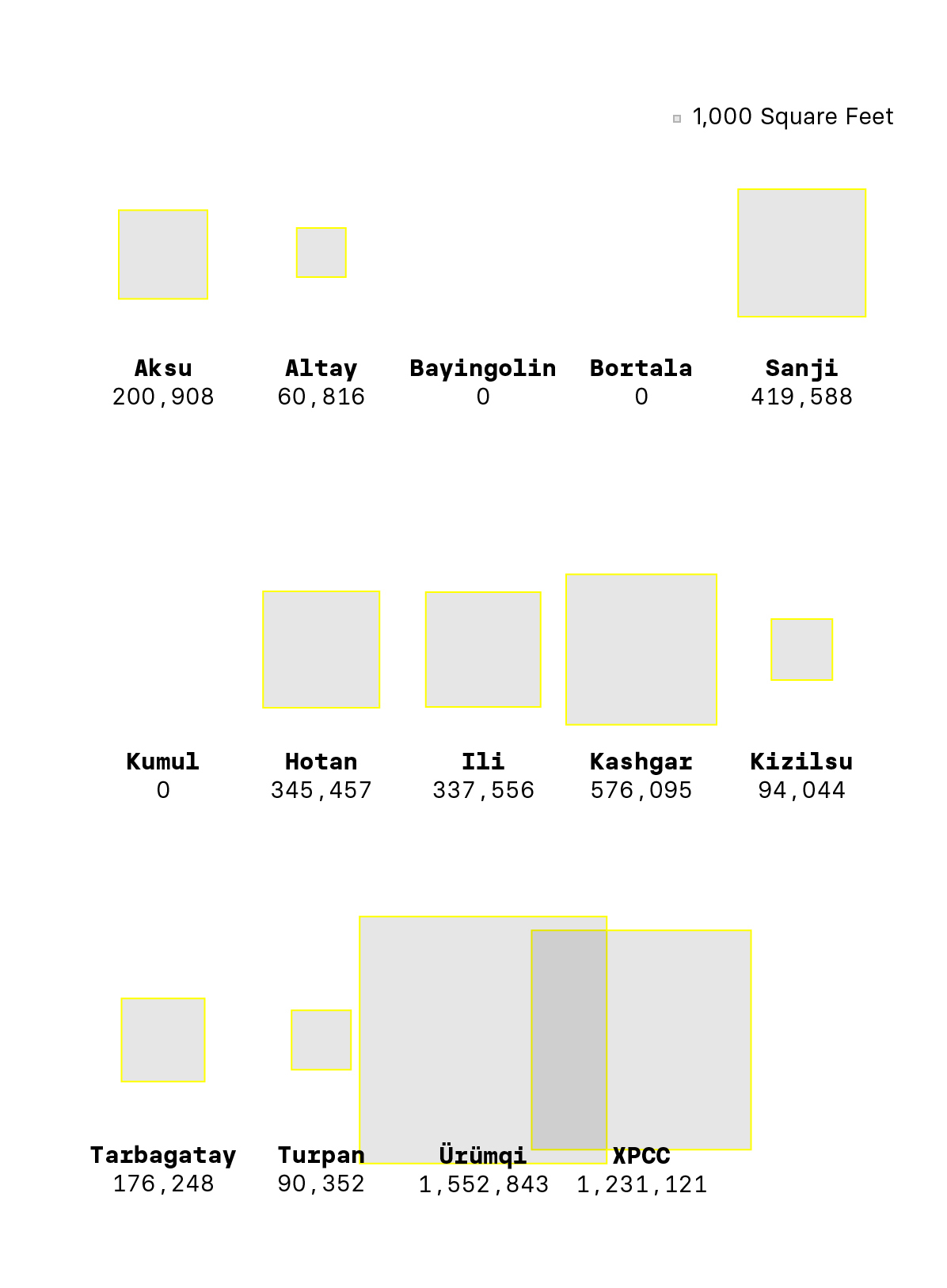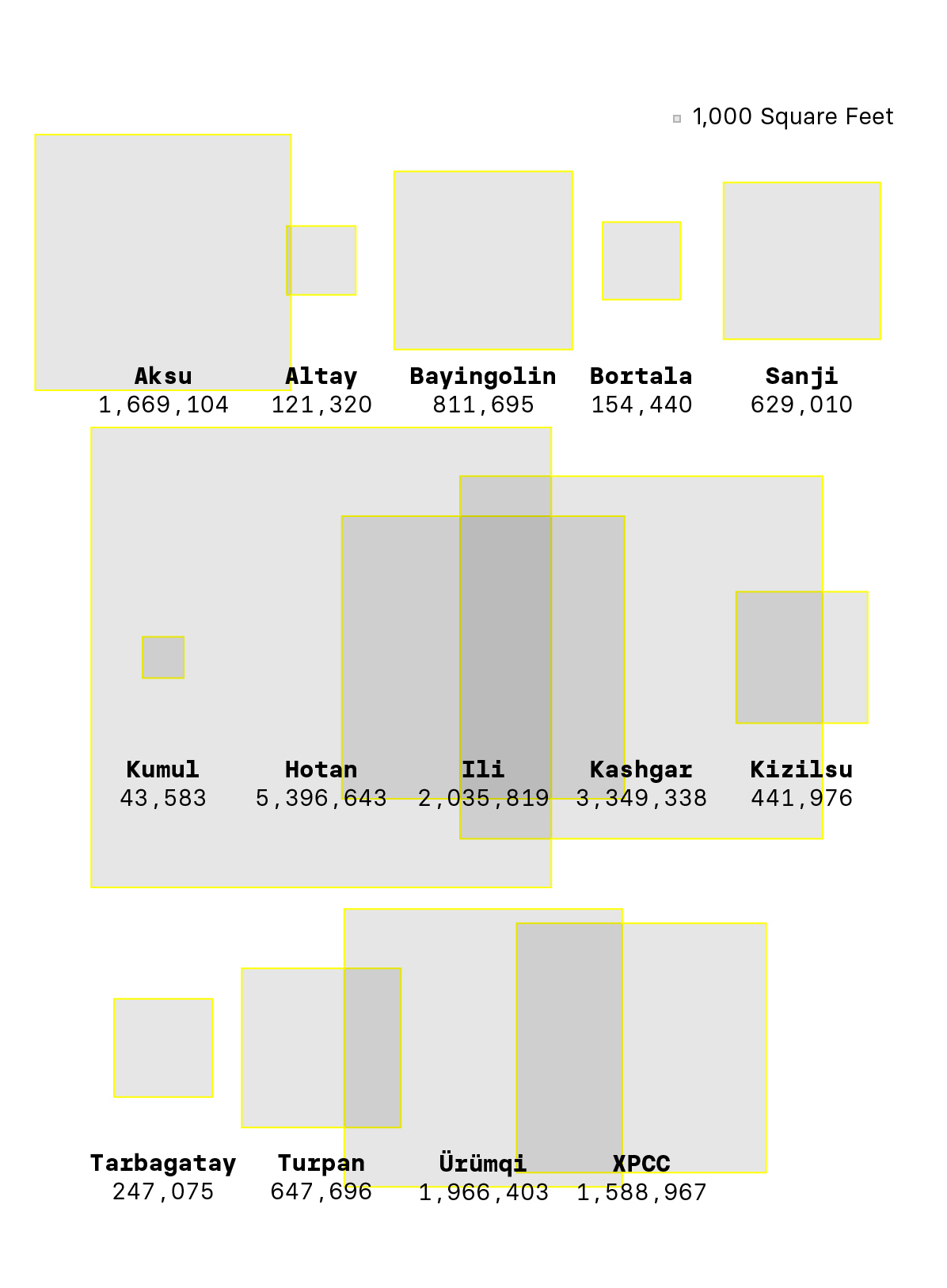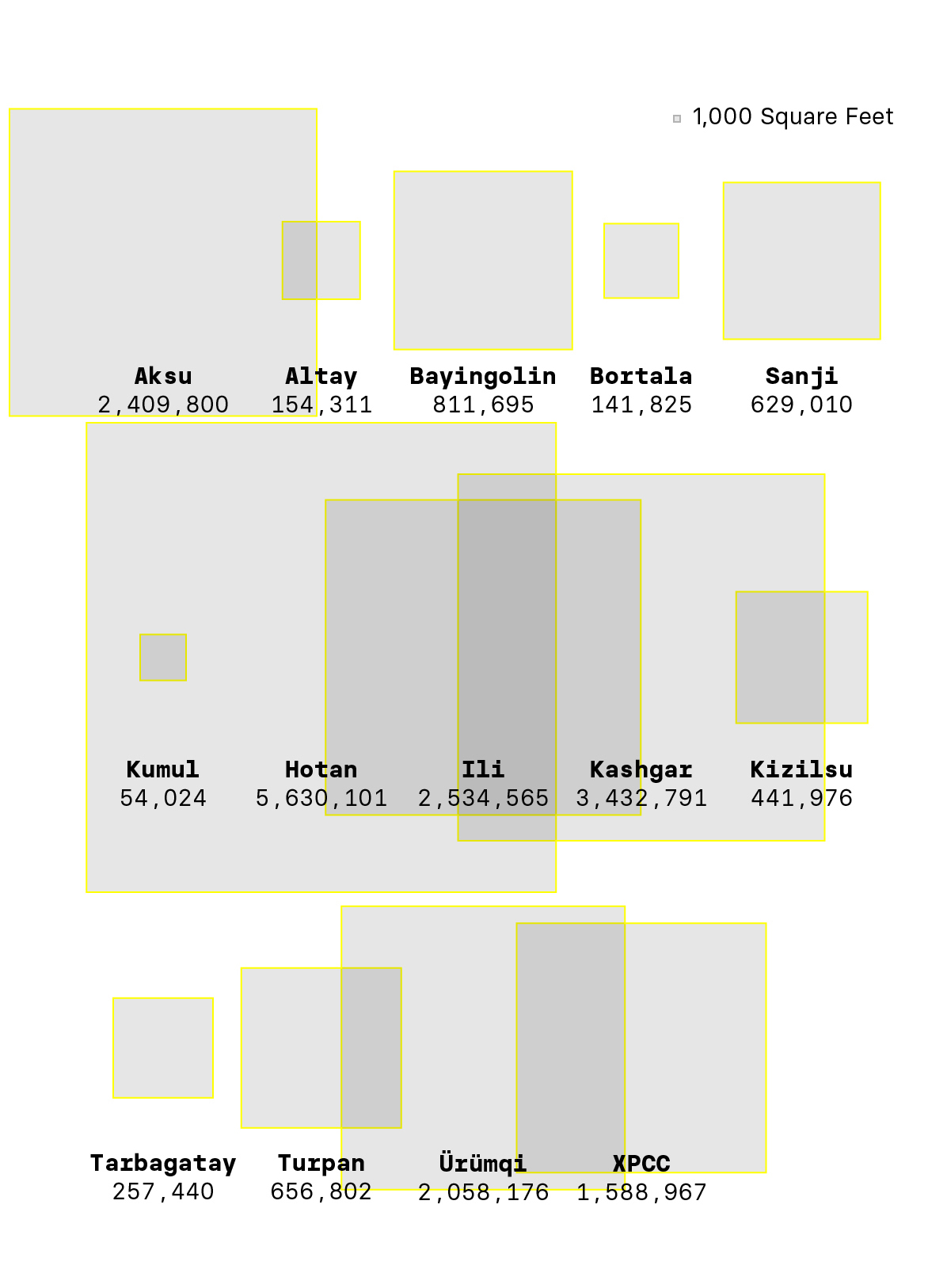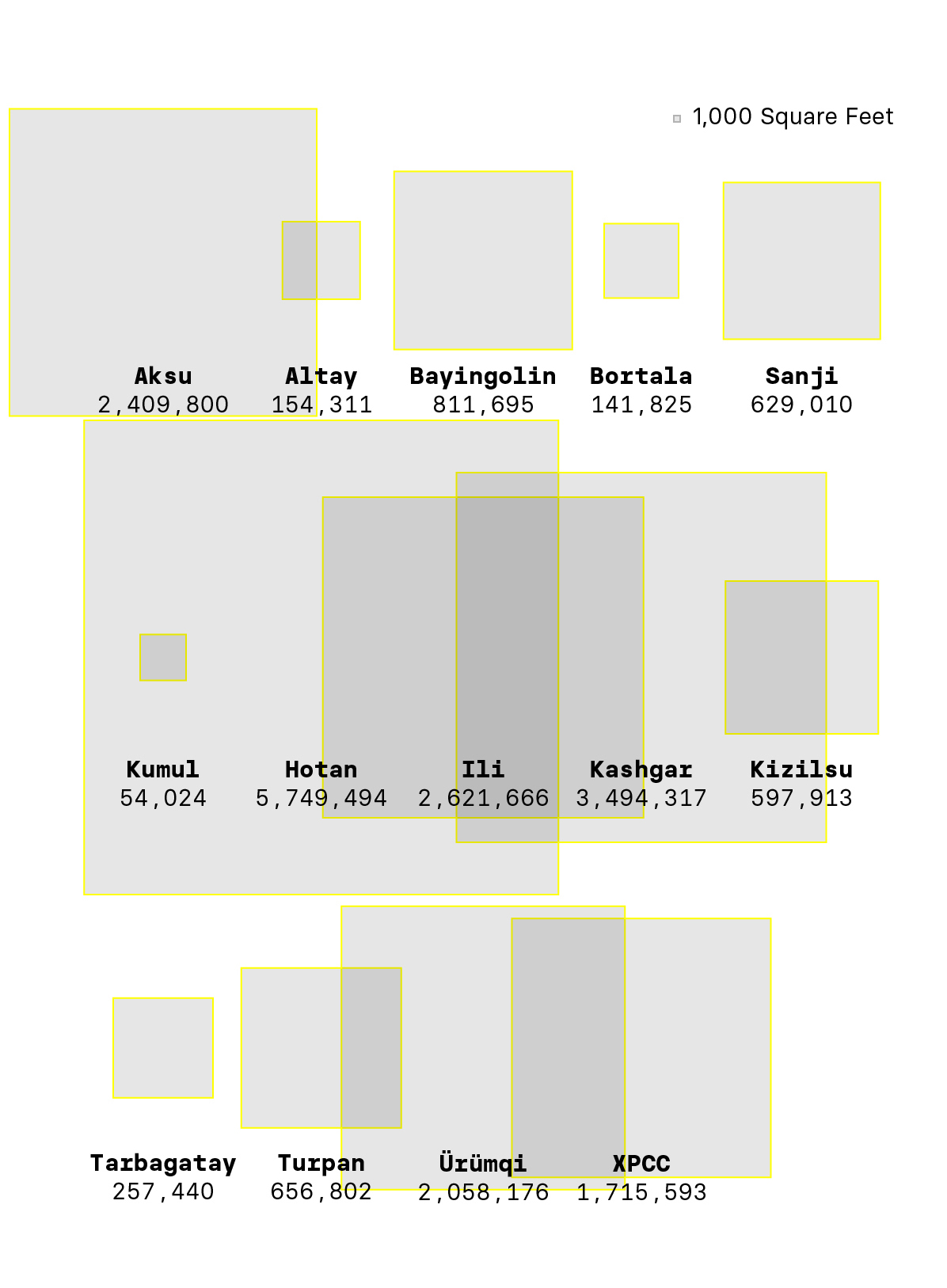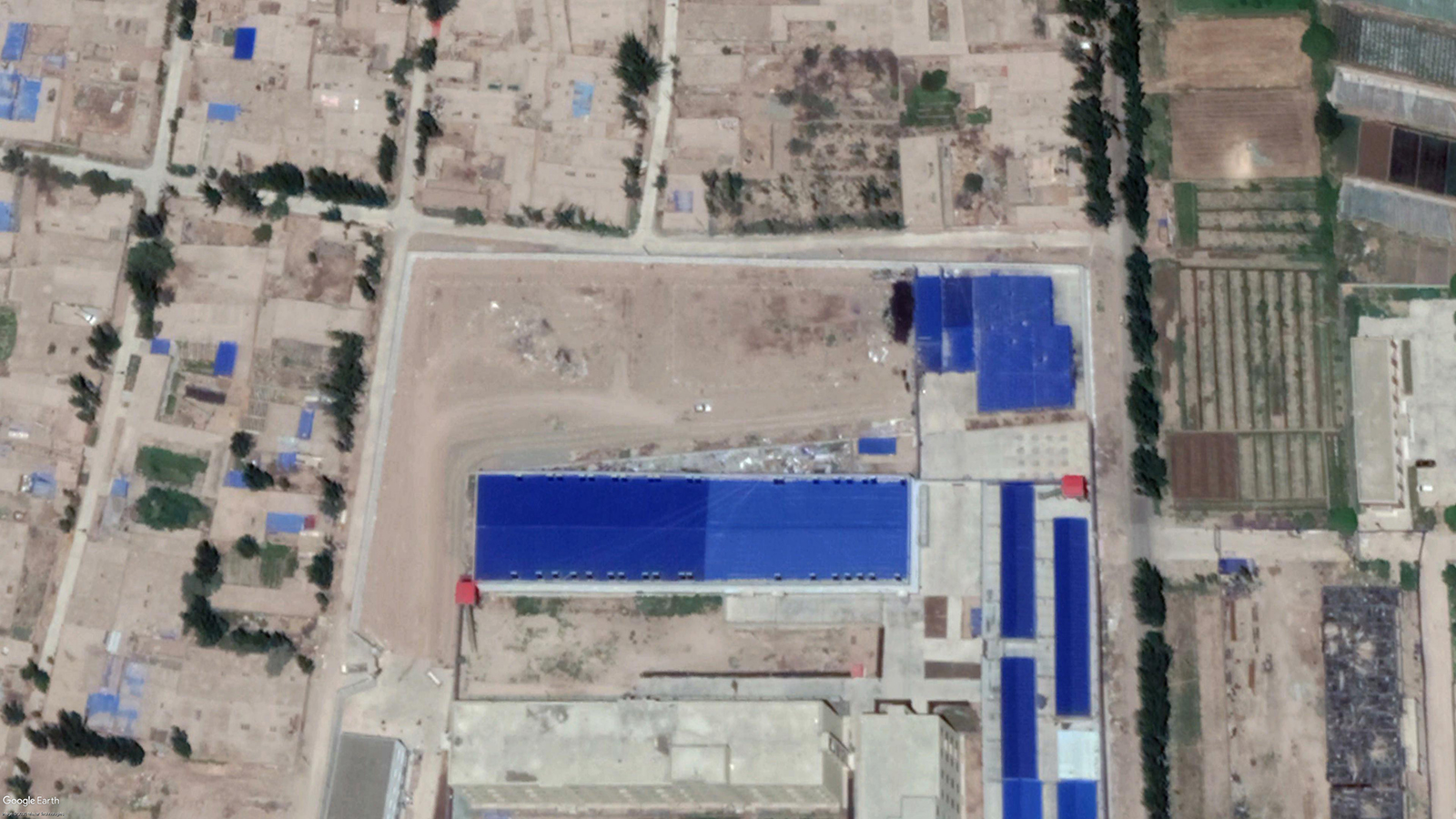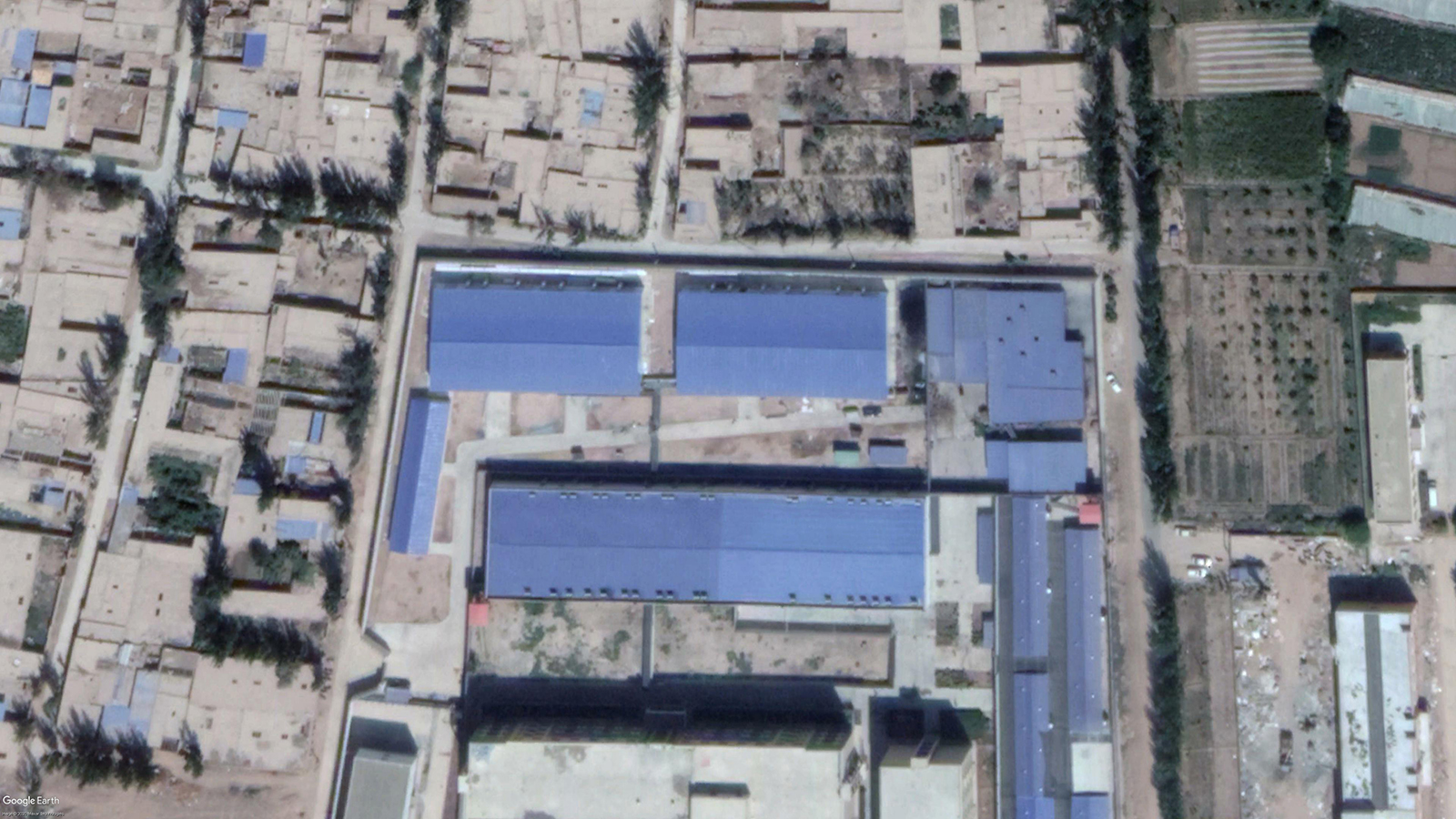This is Part 4 of a BuzzFeed News investigation. For Part 1, click here. For Part 2, click here. For Part 3, click here. For Part 5, click here.
This project was supported by the Eyebeam Center for the Future of Journalism, the Pulitzer Center, and the Open Technology Fund.
ALMATY — China has built more than 100 new facilities in Xinjiang where it can not only lock people up, but also force them to work in dedicated factory buildings right on site, BuzzFeed News can reveal based on government records, interviews, and hundreds of satellite images.
In August, BuzzFeed News uncovered hundreds of compounds in Xinjiang bearing the hallmarks of prisons or detention camps, many built during the last three years in a rapid escalation of China’s campaign against Muslim minorities including Uighurs, Kazakhs, and others. A new analysis shows that at least 135 of these compounds also hold factory buildings. Forced labor on a vast scale is almost certainly taking place inside facilities like these, according to researchers and interviews with former detainees.
Factories across Xinjiang — both inside and outside the camps — tend to share similar characteristics. They are typically long and rectangular, and their metal roofs are usually brightly colored — often blue, sometimes red. In contrast to the masonry and concrete of typical detention buildings, the factories have steel frames, which can be erected within as little as a month. The steel frame is sturdy enough to hold the roof without interior columns, leaving more space inside for large machinery or assembly lines. Some of the biggest factory buildings have strips of skylights to let light in.
Collectively, the factory facilities identified by BuzzFeed News cover more than 21 million square feet — nearly four times the size of the Mall of America. (Ford’s historic River Rouge Complex in Dearborn, Michigan, once the largest industrial complex in the world, is 16 million square feet.)
And they are growing in a way that mirrors the rapid expansion of the mass detention campaign, which has ensnared more than 1 million people since it began in 2016. Fourteen million square feet of new factories were built in 2018 alone.
Two former detainees told BuzzFeed News they had worked in factories while they were detained. One of them, Gulzira Auelhan, said she and other women traveled by bus to a factory where they would sew gloves. Asked if she was paid, she simply laughed.
“They created this evil place and they destroyed my life,” she said.
The former detainees said they were never given a choice about working, and that they earned a pittance or no pay at all. “I felt like I was in hell,” Dina Nurdybai, who was detained in 2017 and 2018, told BuzzFeed News. Before her confinement, Nurdybai ran a small garment business. At a factory inside the internment camp where she was held, she said she worked in a cubicle that was locked from the outside, sewing pockets onto school uniforms. “They created this evil place and they destroyed my life,” she said.
In response to questions about this article, the Chinese consulate in New York quoted a worker from Xinjiang’s Karakax County who called allegations of forced labor in the region “slander” while speaking at a government press conference, saying villagers in the region are earning higher salaries and learning new skills. “We hope everyone can distinguish right from wrong, respect the facts and do not be deceived by rumors,” the consulate added.
Xinjiang’s industry is booming, and the region has one of the fastest GDP growth rates in China. Xinjiang exports a range of products, from clothing to machinery, and the US is one of the region’s fastest-growing markets. Xinjiang’s factories produce many goods that eventually make their way to US consumers. Apple, Nike, and Coca-Cola, among others, lobbied Congress this year to water down a bill that would ban the import of products made with forced labor there. (Apple has said it did not try to weaken the measure, and Nike has said it “did not lobby against” it.) The bill overwhelmingly passed the House of Representatives in September, but the Senate has yet to debate it.
“Corporations should stop producing in, and sourcing from, Xinjiang,” said Scott Nova, executive director of the Worker Rights Consortium. “There is no way to produce responsibly in the region until the forced labor and broader repression ends.”
Nova and other labor rights advocates, as well as experts who have examined the abuses in Xinjiang, argue that forced labor is so widespread in the region that no company that manufactures there could conclude that its supply chain is free from it. That would mean that US consumers have no real way of knowing whether the goods they purchase from Xinjiang are tainted.
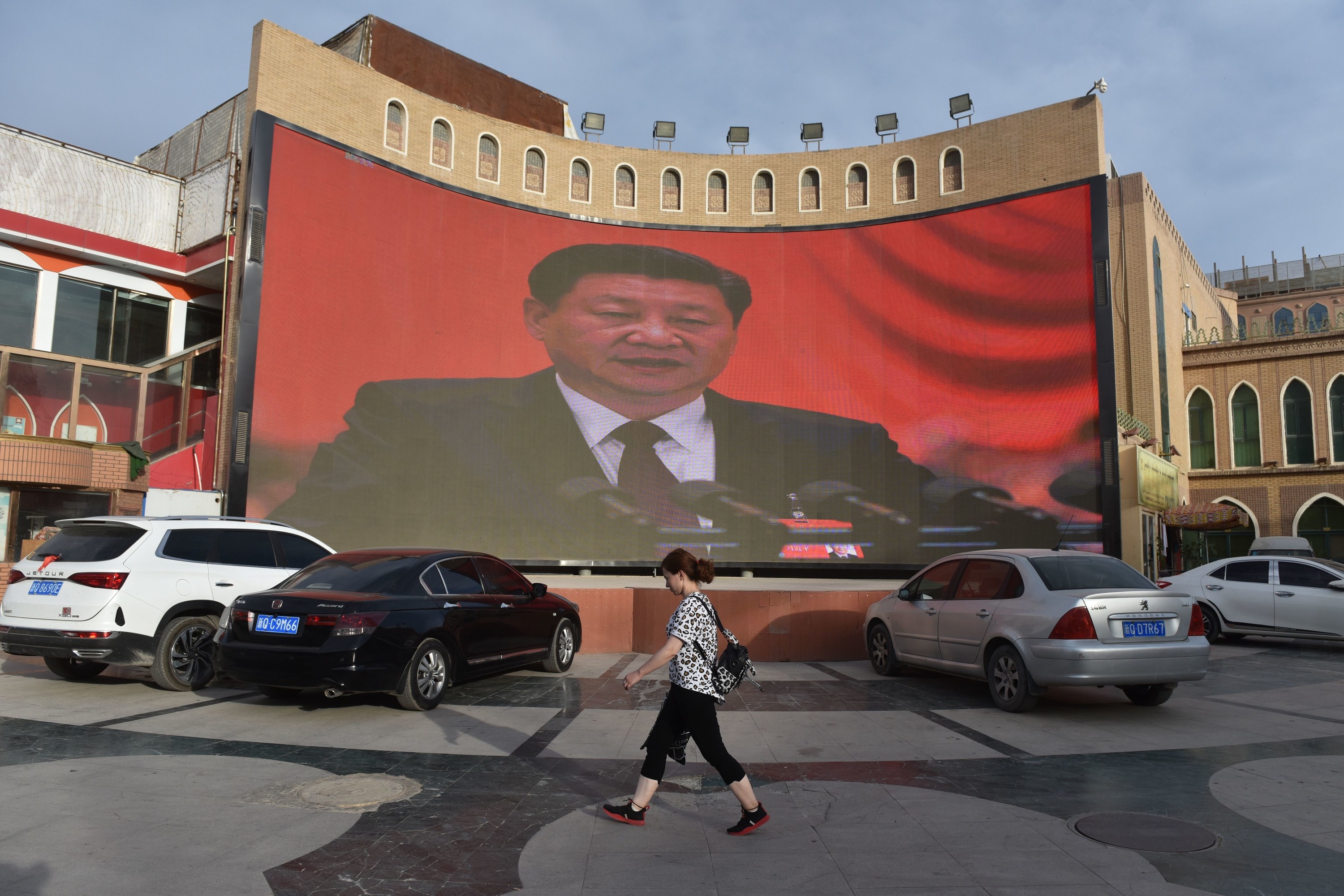
The Chinese government in Xinjiang surveils people so thoroughly and monitors interviews so closely that it is nearly impossible to independently assess if any one factory relies on forced labor. This is especially true given that economic programs, designed to move people out of poverty by moving rural farmworkers into factory jobs, effectively give cover for the government to conceal why a person might be working far from their home. But when factories are located inside internment compounds — cut off from the world by high walls and barbed wire — it beggars belief to claim workers are there willingly.
Detention camp factories are woven deeply into Xinjiang’s economy. The Washington, DC–based nonprofit research institute C4ADS compared the locations of the factories identified by BuzzFeed News to a database that compiles address information from China’s government registry for businesses. C4ADS identified 1,500 Chinese companies located at or right by the factories. Of those, 92 listed “import/export” as part of the scope of their business. BuzzFeed News found further information about these companies in corporate documents, state media reports, and other public data. According to trade data dating back to 2016, some of these companies have exported goods all over the world, including Sri Lanka, Kyrgyzstan, Panama, and France. One company sent pants to California.
One of these firms is Xinjiang Jihua Seven-Five-Five-Five Occupational Wear, which makes military uniforms. It has counted the People’s Liberation Army, the paramilitary People’s Armed Police, and China’s Public Security bureau among its customers, producing hundreds of thousands of pieces of clothing each year.
In its parent company’s 2019 annual report, the company is explicit about its participation in labor transfer programs, which experts have linked to forced labor. The company transferred at least 45 ethnic minorities “who do not speak Chinese” from southern Xinjiang to work, the report says. They stayed in shared rooms holding three or four people, according to the report, and they received a monthly food stipend of 360 yuan (about $55).
An article in the state-controlled China News Service said the company’s workers at its Hejing branch were laboring overtime to fulfill a clothing order for protective coveralls, having already skipped a vacation that the factory manager said was offered last year. The workers also attend “bilingual night school” to learn Chinese. Every Monday, they hold a flag-raising ceremony and sing the praises of the Communist Party’s policies as well as “socialist thought with Chinese characteristics in the Xi Jinping new era.”
The way these workers were treated tracks with China’s known behavior in the region. The government’s anti-poverty campaign moves impoverished ethnic minorities referred to as “surplus labor” to jobs ranging from picking cotton to sewing clothing, though workers inside the camps are likely from a different stream of labor. Local policy documents refer to these “surplus” workers as having “lazy thinking” and praise the government for “creating an atmosphere that labor is glorious and laziness is shameful,” according to recent research on Xinjiang from the German scholar Adrian Zenz.
Zenz and other researchers say these “labor transfers” can be a front for forced labor, especially in an environment where Muslim minorities live in fear of being arbitrarily locked up. But Zenz added that factory labor that takes place within internment camps is from a policy scheme that is distinct from the labor transfer programs, with factories in the camps often called “poverty alleviation workshops.” He said that “graduates” from the camps can end up working alongside workers involved in the wider labor transfer scheme.
As part of its campaign targeting ethnic minorities in the region, the government has also crushed education in minority languages. Dozens of ex-detainees told BuzzFeed News they were forced to study Chinese in internment camps and regularly praise the ruling Communist Party.
One of Xinjiang Jihua’s registered addresses matches the location of a large complex of internment facilities, which together can hold 11,700 people. This sprawling installation lies just over 3.5 miles from the center of Hejing county, in an isolated area bounded by empty plots of land and an industrial estate to the north and farmland to the south. Six blue-roofed factory buildings sit in their own compound right in the middle of the complex. They appear to be linked directly to adjacent detention buildings via a gate in the wall. It's not clear whether workers at this facility came via labor transfer programs.
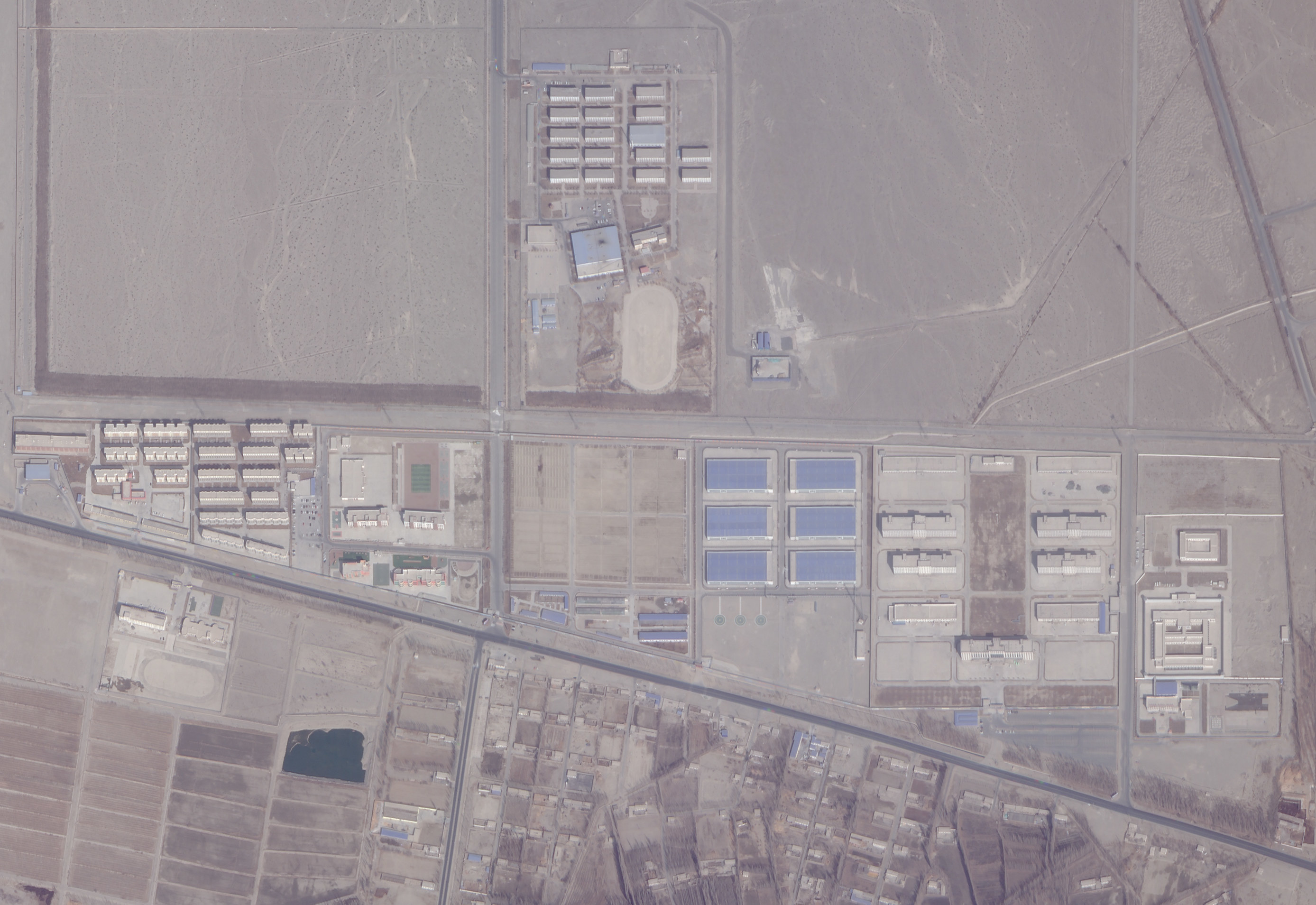
Xinjiang Jihua did not respond to multiple requests for comment.
Another company, Hetian Yudu Handicrafts, is registered inside a compound in Lop County in southern Xinjiang; satellite photos show it bears the telltale signs of an internment camp. A state media article about labor transfer programs in the area quotes a Uighur woman, who went to work for the company weaving carpets, promising to earn a “surplus” for the company. Hetian Yudu did not respond to multiple requests for comment.
Labor transfer for Uighurs, Kazakhs, and Xinjiang’s other minority groups extend beyond the region to other parts of China. The Australian Strategic Policy Institute, a Canberra-based think tank that has published research documenting human rights abuses in Xinjiang, in March identified 27 factories in nine Chinese provinces using Uighur and Kazakh workers from Xinjiang under a government labor transfer program. Refusing these work assignments is “extremely difficult,” the institute found, because they “are enmeshed with the apparatus of detention and political indoctrination.”
In many cases, Chinese language state media articles show photos of migrant workers who appear to be ethnic minorities boarding buses or working on assembly lines. The articles say that they’re participating in a poverty alleviation program. But they’re subject to strict controls and constant surveillance, and live in fear of being sent to camps or otherwise punished if they don’t comply. After work, they must participate in “patriotic education,” according to former detainees and Chinese language news articles about the programs.
A white paper published by the Chinese government in September offers clues into the scale of the program, saying the average “relocation of surplus labor” per year topped 2.76 million people.
According to state media reports, efforts to alleviate poverty in Xinjiang comprise a wide range of industries ranging from textile factories and food processing to livestock slaughter and cotton farming. It’s unclear what portion of workers in these programs are being forced to work, underpaid, or otherwise mistreated. But experts say the number is large and growing.
“Research suggests that some of those transferred to work are not willing and are severely underpaid, raising concerns about forced labor, potentially at a significant scale,” the Washington, DC–based think tank Center for Strategic and International Studies found. The US Department of Labor estimated that 100,000 Uighurs and other ethnic minorities are working in forced labor.
The Better Cotton Initiative, an industry group that promotes ethical standards for cotton producers, told the BBC this month that it had stopped auditing and certifying farms in Xinjiang in part because the poverty alleviation schemes cast the shadow of forced labor over the entire industry there.
The abuses in Xinjiang may affect the supply chains of some of the world’s most recognizable brands. In its March report, the Australian Strategic Policy Institute also identified 82 multinational companies with suppliers that used Uighur workers outside Xinjiang as part of a labor transfer program, including Abercrombie & Fitch, Dell, Apple, Amazon, H&M, Nike, Nintendo, General Motors, and others.
Some brands said they stopped working with those suppliers this year, according to the Institute’s report. Others said they had no contractual relationships with suppliers involved in labor transfer programs, “but no brands were able to rule out a link further down their supply chain,” the report says. Apple said in July that it had found no evidence of forced labor on its production lines.
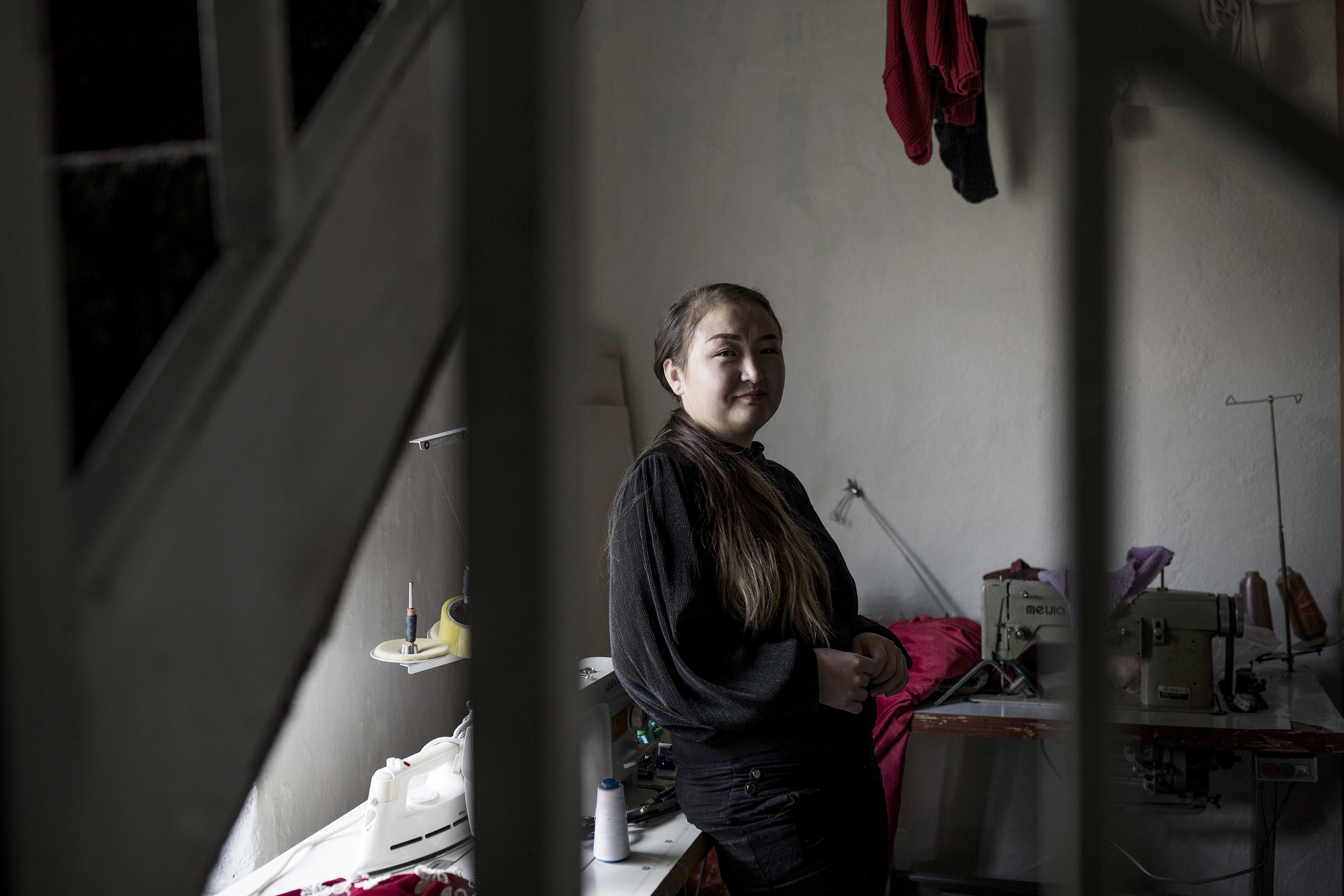
Nurdybai turned 28 this year. She’s a busy woman, with a toddler she dotes on and a fledgling garment business she’s started in her new home in Almaty, Kazakhstan. In person she is fresh-faced, with perfectly microbladed eyebrows and wisps of bright green shadow brushed across her eyelids.
Her ordeal started in 2017. At the time, she was running a tailoring shop and a second thriving business selling traditional Kazakh-made clothing in China, called Kunikai Clothing. The company employed about 30 people and specialized in the intricate embroidery found on traditional Kazakh clothing, even offering training and consulting on the complex designs, according to public records. A photo that year shows her posing at a trade expo in the regional capital of Ürümqi, wearing a sleek black sheath dress and big dark sunglasses. She was hands-on in her factory — another old photo shows her explaining to workers how to cut fabric, the cuts marked with a chalked-on dotted line.
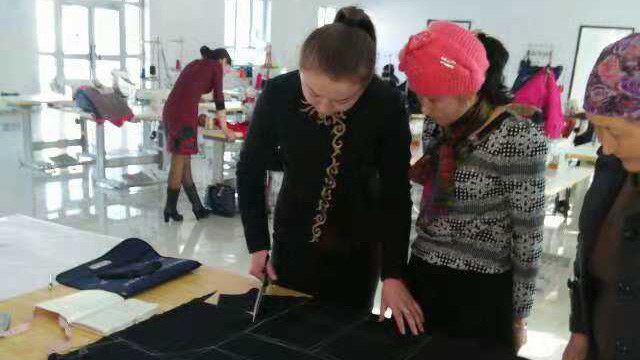
One night in October 2017, she returned from work so burned out that she immediately turned her phone off and collapsed into bed. She later found out that the police were looking for her that night and had phoned several of her relatives to try and reach her. The next morning, they called again, and then came to her door.
She was taken to a camp not far from where she lived in the county of Nilka, located in northeast Xinjiang, near the border with Kazakhstan. Located in the Kashgar River Valley, Nilka is small and remote, and manual labor is embedded in its history — one of its few tourist sites are the ruins of an ancient copper mine.
The camp was growing quickly. It seemed to Nurdybai that dozens of people were coming in each day, often wearing hoods so they could not see. “You could hear the clinking of their shackles as they came in,” she said.
There was no heating, and she shivered all the time in her thin uniform. There were 16 women in her dorm room. Inside, she was given a book of Chinese President Xi Jinping’s speeches. Instead of running her tailoring shop or fulfilling clothing orders, she would now spend three and a half hours each day studying Xi’s speeches. She couldn’t understand why. Soon enough her days would be filled with labor.
Forced labor has a long history in Xinjiang that predates the detention campaign. Some lower-security prisons were linked to farms, while many high-security prisons contained heavy industrial facilities, such as a smelting plant for lead and zinc, fertilizer plants, and coal and uranium mines. A few contained buildings for light manufacturing.
Factories started appearing in the makeshift camps of the early detention campaign in spring 2017. Often they appeared as a single factory wedged onto the site wherever there was room, squashed between the existing buildings, or built on the sports field of a former school. At the same time, new and expanding high-security facilities also added factories, typically in larger numbers.
With the explosion of factory-building in 2018, new patterns emerged. The piecemeal addition of factory buildings on cramped existing sites continued. But the detention compounds on the edge of cities, which had more room, expanded to accommodate new factories that were typically arranged in a neat grid and often separated from the main compound — by a fence, or even a road with barbed wire walkways connecting the two. The factory area often had a separate entrance from the surrounding roads, allowing raw materials to be delivered and finished goods to be picked up without disturbing the wider camp.
While some of the new factories have been built in higher-security facilities, they are more often found in lower-security compounds, and they appear to be for light industry — manufacturing clothes rather than smelting zinc or mining. Much of the construction since 2017 has been concentrated in Xinjiang’s south and west: the regions with the highest numbers of Uighur and Kazakh people.
Hotan prefecture, for instance, contains nearly a third of the factories built between the start of 2017 and the end of 2020. Two counties within it — Hotan and Lop — saw 1.9 million square feet and 1.8 million square feet of factories built there respectively during that time period.
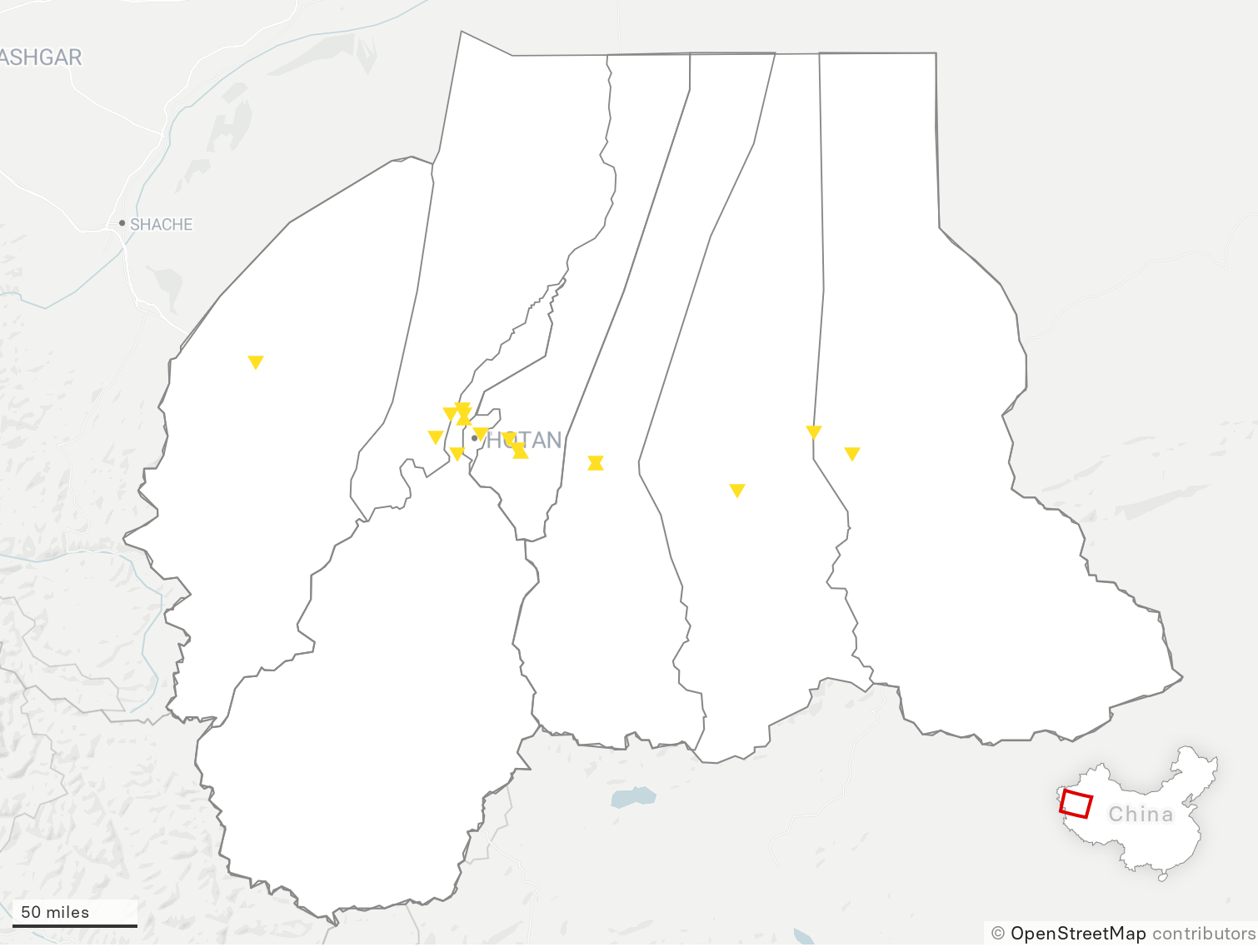
Forced labor in Xinjiang ramped up in 2018, according to researchers and news reports. One ethnic Kazakh factory owner from northern Xinjiang, who asked that her name and company be withheld out of fear of retaliation, described the government’s relentless efforts to round up workers that year. BuzzFeed News was able to verify details about her company’s registration. “I was an entrepreneur. I had a small garment factory,” she said. “I had to go through a lot of bureaucracy, but I did it.”
In 2018, police officers visited her factory five times, asking her to recommend workers to be “reeducated” in order to meet a quota. They told her to look for behavioral slights — using a ceramic bowl with Uyghur-language writing on the bottom, for instance, or repeatedly wearing a headscarf for women.
“We had heard that mass detention had occurred, that people were disappearing into these schools. We didn’t know much but we knew that it wasn’t a good place.”
All five times, she managed to fob them off, offering bribes and excuses.
The business owner had heard rumors that the internment camps were not for education, as the government claimed, but mass detention. “We had heard that mass detention had occurred, that people were disappearing into these schools. We didn’t know much but we knew that it wasn’t a good place,” she said. She was afraid of being sent to a camp herself, but she could not bear to hand over the names of her workers either. “I never sent a single person to the camp,” she said, a note of pride creeping into her voice.
Government officials also told the entrepreneur about poverty alleviation programs, saying that people could get jobs in other parts of the country, which ethnic Kazakhs sometimes call “inner China.” A group of people from her village departed for one of these programs, she said. They returned in six months and told her they had been paid much less than they were originally promised, she said.
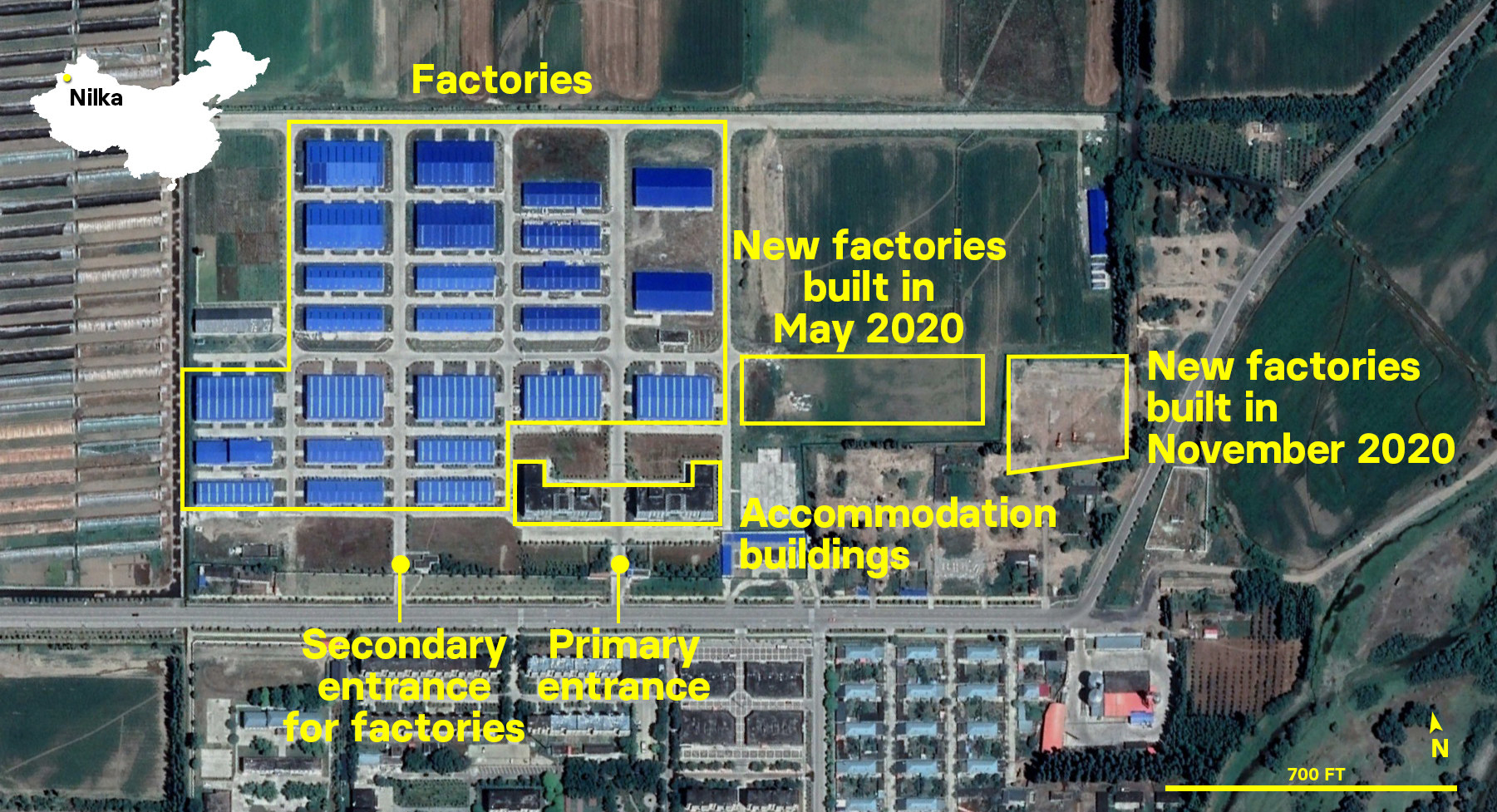
By May 2018, Nurdybai was moved to another camp in Nilka County — one of several in which she’d been held. That summer, the camp contained two residential buildings and several blue-roofed factories, with two more under construction, satellite images show. The first buildings in the compound — two five-story residential buildings and 11 factories — had likely been built by late 2015. By the time Nurdybai arrived, an additional 15 factories had been added, covering the grassy field at the northern end of the site.
Much later, after she had moved to Kazakhstan, Nurdybai found the location of the camp herself on Google Earth. It looked strangely familiar. Yet, by then, it had grown even more.
In October 2019, construction started on four more factories, but the workers only finished building the steel frame before the first snow arrived in the second week of November and they had to stop work. They finished by May of this year, and three further factories were added this fall. There are now 33 factory buildings in the compound. Together, they cover 428,705 square feet, an area larger than seven football fields.
Nurdybai stayed at the camp for a couple of months before she was ordered to work in one of the factories in the camp. When officials realized she had worked in the garment industry in the past, she was told to teach other women how to sew clothes — school uniforms, she remembered. She taught them how to sew square pockets on the tops of the tunics and how to sew a collar straight.
“It was a huge place. There were so many women in there. They were all like me — prisoners,” she said.
She said she was paid a salary of 9 yuan — about $1.38 — in a month, far less than prevailing wages outside the walls of the detention camp.
It was a short walk to work — the distance from the residential buildings to the nearest factory was only 25 yards or so, while the farthest, on the opposite side of the site, was still just five minutes away. The women would work from 8 a.m. to noon, she said, and after lunch, again from 1:30 p.m. to 6:30 p.m. After the nine-hour day, they were required to take classes back in the building where they stayed, memorizing and repeating Chinese Communist Party propaganda and studying Mandarin Chinese.
The factory was equipped with new sewing machines, Nurdybai remembered. In fact, all the equipment inside looked new. But there were clues that those who worked there were not doing it by choice. Pairs of scissors were chained to each work table to prevent the women from taking them to the dorms, where they could, in theory, use them to harm themselves or stab the camp’s guards. And there were cameras everywhere, Nurdybai said, even in the bathrooms.
Inside the factory building, the floor was divided up, grid style, Nurdybai said. It was not like the factories that she had seen while running her own business. “There were cubicles at about chin height so you couldn’t see or talk to others. Each had a door, which locked,” she said, from the outside. Each cubicle had between 25 and 30 people, she said.
On one occasion, one of the camp staff justified the locked cubicles by saying, “These people are criminals, they can seriously harm you.” Police patrolled the floor of the factory.
Nurdybai ate with the other workers and slept in the same quarters as them. But, she said, her position as a trainer gave her one special privilege: She had a key fob with which she could open the doors to the bathroom. Others had to ask for permission to go.
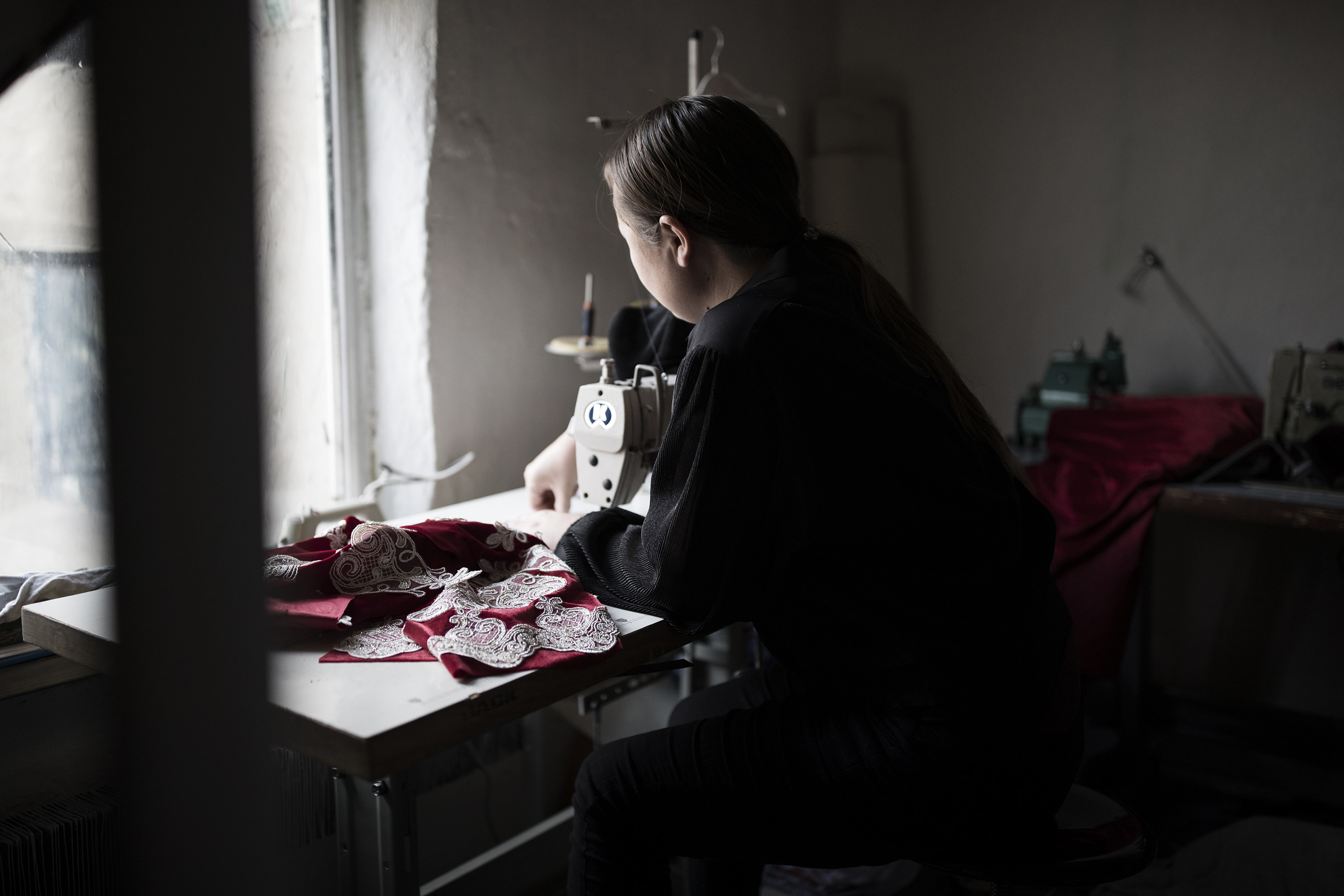
Near the end of Nurdybai’s time in internment camps in September 2018, police officers finally told her what she was said to have done wrong: She had downloaded an illegal app called WhatsApp. She was later released and told her “education” was over. Her boyfriend at the time brought her a bouquet of flowers, as if she had just come home from a long trip.
But in the time she spent in the camps, her life had fallen apart. She owed a bank 70,000 yuan, or about $10,700, in business loans, on which she had been unable to make payments while she was detained.
Her clothing orders, too, had sat unfulfilled. “They took everything from my factory — expensive materials — they took it,” she said. “My customers, I had to pay them back.” She began selling off her possessions, even her car, to try and pay down the loan.
“I’ve learned to cherish my freedom.”
Eventually, she saved up enough money to leave China and immigrate to Kazakhstan. She is still paying back her loans in China, though she managed to negotiate them down with the bank. Mostly she tries to take things one day at a time. “I’ve learned to cherish my freedom,” she said. “Before all this, I was successful. I had money. But now I understand that money is nothing without freedom.”
She started a small garment business again. She had a baby. And she began speaking out about what had happened to her, telling the story of how she lost everything she had worked for.
She went to the offices of Atajurt, a small human rights NGO located in a worn-down building in central Almaty. It didn’t have much in the way of resources — on a visit this year, a conference room door was broken and had to be held shut by a strip of red ribbon. But it had quickly become a hub for ex-detainees from Xinjiang’s camps, who often came to record their stories for YouTube, and to speak to journalists and university professors visiting the city.
Nurdybai’s workshop is in a small two-floor building tucked away in a residential neighborhood on the outskirts of Almaty, lined with houses and a neighborhood school. Inside, there’s just one window, with a narrow staircase whose railing is painted white. On the first floor, her workshop was strewn with scraps of fabric in purple and red, with two sewing machines set on tables.
She was a healthy woman before her internment. But after she was detained she developed a hernia, which still causes stabbing pains in her abdomen — she suspected she got it from being forced to sit for long hours while studying Chinese. Worse, she began to get migraines, which started with searing pain that moved up the back of her neck. She wondered if the ice-cold showers she had been forced to take could be to blame.
“I worked hard for 10 years to succeed,” she said. “I lost everything, including my health.” ●
Ekaterina Anchevskaya contributed reporting.



